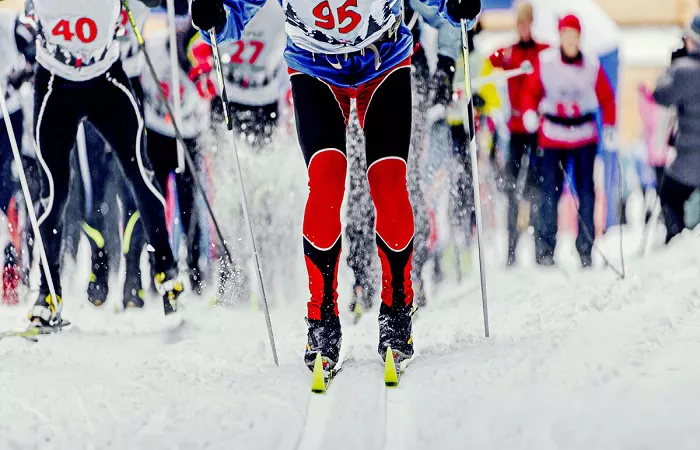Cross-country skiing stands as one of the most physically demanding endurance sports, engaging nearly every major muscle group in a continuous symphony of movement. Unlike cycling or running, which primarily target the lower body, cross-country skiing demands a perfect balance of upper-body strength, core stability, and lower-body endurance. But what exactly are the key muscles that propel you across snowy terrains with efficiency and power? This article provides a detailed breakdown of the primary and secondary muscles involved in cross-country skiing, explaining their roles and how they contribute to your performance. Whether you’re a competitive skier or a recreational enthusiast, understanding these muscular interactions can help you refine your technique, prevent injuries, and maximize your training efficiency.
The upper body generates crucial propulsion and rhythm
While many endurance sports focus predominantly on the legs, cross-country skiing places significant demands on the upper body, particularly in techniques like the classic diagonal stride and skate skiing. The latissimus dorsi—the broad muscles spanning your mid-to-lower back—serve as the primary drivers of the poling motion. These powerful muscles contract forcefully during the downward push of the poles, propelling you forward with each stroke.
Working in tandem with the lats, the triceps brachii (located at the back of your upper arms) extend your elbows, ensuring a strong and efficient pole push. The deltoids, particularly the anterior (front) and posterior (rear) portions, stabilize your shoulders throughout the motion, preventing unnecessary strain and maintaining proper form. Additionally, the pectoralis major (chest muscles) assist in the forward arm swing, contributing to the fluidity of your poling rhythm.
Even smaller stabilizing muscles, such as the rotator cuff group, play a critical role in maintaining shoulder joint integrity. Given the repetitive nature of poling, these muscles help prevent overuse injuries, ensuring that your shoulders remain strong and mobile over long distances.
The key link between upper body and lower body movements
A strong and stable core is essential for efficient energy transfer in cross-country skiing. The rectus abdominis (the “six-pack” muscles) and the obliques (side abdominal muscles) work continuously to keep your torso upright and balanced, especially during dynamic weight shifts and terrain changes. These muscles prevent excessive torso rotation, allowing for smoother and more controlled movements.
The erector spinae, a group of muscles running parallel to your spine, play a vital role in maintaining proper posture. They counteract the forward lean often seen in skiing, ensuring that your back remains aligned and reducing the risk of lower back fatigue. Without a strong core, the power generated by your arms and legs would dissipate, leading to wasted energy and decreased efficiency.
Additionally, the transverse abdominis (the deepest core muscle) acts like a natural corset, stabilizing your pelvis and spine. This muscle is particularly important during the glide phase, where maintaining a steady and balanced torso is crucial for maximizing forward momentum.
The lower body provides the foundation for power and endurance
While the upper body and core contribute significantly, the legs remain the primary powerhouse in cross-country skiing. The quadriceps femoris, a group of four muscles at the front of the thigh, are responsible for knee extension during the kick or push-off phase. These muscles endure constant loading and unloading, making them essential for generating speed and maintaining endurance over long distances.
The hamstrings, located at the back of the thighs, work in opposition to the quads, controlling knee flexion and assisting in hip extension. During the recovery phase of each stride, the hamstrings help bring the leg back, preparing it for the next powerful push.
The gluteus maximus, the largest muscle in the body, plays a pivotal role in hip extension, particularly during the forceful push-off in skate skiing. Strong glutes not only enhance propulsion but also help stabilize the pelvis, reducing the risk of imbalances and injuries.
Meanwhile, the hip flexors, including the iliopsoas, are crucial for lifting the legs during the recovery phase. Tight or weak hip flexors can lead to shortened strides and decreased efficiency, making them an important focus for skiers looking to improve their technique.
The calf muscles (gastrocnemius and soleus) also contribute by stabilizing the ankles and assisting in the final push-off. While their role is less dominant compared to the larger leg muscles, they are still essential for maintaining balance and control, especially on uneven terrain.
Secondary muscles contribute to stability and fine-tuned control
Beyond the major muscle groups, several smaller muscles play supporting roles in cross-country skiing. The tibialis anterior (front of the shin) helps with dorsiflexion, ensuring proper foot positioning during the glide phase. The intrinsic foot muscles maintain balance and adapt to changing snow conditions, providing subtle adjustments that enhance grip and control.
The trapezius and rhomboids in the upper back assist in shoulder stabilization, particularly during prolonged poling. Meanwhile, the forearm muscles (flexors and extensors) maintain a firm grip on the poles, ensuring that energy is efficiently transferred with each push.
Conclusion
Cross-country skiing is a true full-body workout, engaging muscles from head to toe in a coordinated effort to maintain speed, balance, and endurance. Understanding the roles of these muscles can help skiers tailor their training programs, focusing on strength, flexibility, and muscular endurance where it matters most. By strengthening the lats, core, quads, and glutes—while also paying attention to stabilizing muscles—you can enhance your efficiency, reduce fatigue, and enjoy smoother, more powerful strides on the snow. Whether you’re training for a race or simply enjoying winter trails, optimizing your muscular engagement will elevate your skiing experience to new heights.
Related topics
- WHEN DOES TYROL BASIN OPEN FOR SKIING IN 2025?
- WHEN DOES ABASIN OPEN FOR SKIING?
- WHAT IS A QUIVER SNOWBOARD?

